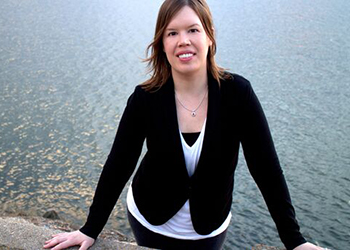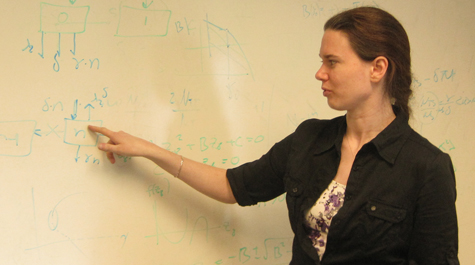Calculating contagion: Researchers examine social aspect of pathogen spread
If Leah Shaw gets any time to herself during this period of social distancing, she plans to run a simulation — on social distancing.
Shaw is an associate professor in William & Mary’s Department of Mathematics. Her research focuses on modeling the dynamics of biological populations, including the spread of epidemics.
“Here’s the simulation,” Shaw said. “Let’s say you implement social distancing. You’ll see all these connections outside households go down, but the connections inside will go up. So, we could ask how much that affects disease spread.”
The U.S. Centers for Disease Control and Prevention defines social distancing, as it applies to COVID-19, as "remaining out of congregate settings, avoiding mass gatherings, and maintaining distance (approximately 6 feet or 2 meters) from others when possible."
The strategy is a numbers game. The fewer interactions between people, the lower the chances of the disease spreading. Mathematical models have been used to understand the spread of infectious diseases since the time of Bernoulli. But the 17th century epidemic models are not all that relevant today, Shaw said.
“In those models, the population was considered homogeneously mixed,” Shaw said. “Every individual had an equal chance to contact any other individual in the population. Those models weren’t realistic even at the time they were developed, but they’re simpler, so they were the starting point. Once you start putting models on a social network, instead of assuming they're well-mixed, the individuals are now different. My connections aren't the same as your connections.”
Shaw studies the problem of disease spread by using computational tools developed for mathematical biology and statistical physics. Her research uses simple models (what researchers call “toy models”) that contain a few aspects of reality, but are pared down compared to all the variables involved in real-world epidemic spread.
“One problem with modeling the social aspects of transmission is they depend on people's behavior, which is very difficult to predict,” Shaw said. “In any modeling you do, you have to make assumptions or else you don't have a model. But the validity of the output is probably only as good as the assumptions that went into the model.”
Her models account for community response, what she calls “an adaptive social network.” When an epidemic spreads in a population, she explained, people may adaptively change the structure of their social-contact network to reduce risk of infection.
In other words, certain individuals may choose to self-quarantine and socially distance themselves from others to prevent the spread of disease. Shaw’s research has shown social distancing could fundamentally alter community structure, even after the initial outbreak has subsided.
“The idea behind adaptive behavioral epidemiology is that groups and individuals respond to the knowledge of a disease threat by changing their habits to avoid interactions with those who are contagious,” Shaw wrote in a paper co-authored with Ira Schwartz of the Naval Research Laboratory. “Network-based models take this adaptive behavior into account by allowing the network to ‘rewire’ its connections.”
 There is a key assumption built into Shaw’s models: people will do the right thing and self-quarantine after exposure. That may be easier said than done, especially in the case of a pandemic that crosses cultures.
There is a key assumption built into Shaw’s models: people will do the right thing and self-quarantine after exposure. That may be easier said than done, especially in the case of a pandemic that crosses cultures.
It’s natural for human beings to want to be near one another, but the proximity and frequency of social interaction varies between societies says Joanna Schug, associate professor in William & Mary’s Department of Psychological Sciences.
“My research suggests that, in some countries, people are much more likely to come into contact with strangers or form relationships with new people,” Schug said. “In other countries, people tend to be more embedded in their existing social networks.”
The scientific term is “relational mobility.” It describes how individuals interact and develop relationships in different societies. Cultures in which people tend to mix readily are said to have high relational mobility. Schug was part of a research team that found relational mobility was lower in societies that practiced settled, subsistence lifestyles, such as rice farming.
Schug’s team also found similar low relational mobility in societies that had stronger ecological and historical threats, such as a harsh geoclimate, poverty or a history of pathogens.
“What was amazing about this study is we were able to predict outcomes in terms of people’s relationships using this social ecological concept,” Schug said. She explained that behaviors exhibited by each culture were adaptive to their specific social environments.
Schug is not collecting data on the spread of COVID-19, but she says it could be valuable for researchers to examine relational mobility.
“My research has shown that in some countries, people are much more likely to come into contact with strangers and form relationships with new people,” Schug said. “In other countries, people tend to be more embedded in their existing social networks.”
She says this could be a reason why countries like Singapore, South Korea and China, which are low on the relational mobility scale, were quick to adopt extreme social distancing measures and limit spread. Meanwhile, in high relational mobility places like Italy and the U.S., the virus is showing an exponential growth in transmission.
“To be clear, this is a hard thing to tell because not enough people are getting tested to see the true spread of the virus,” Schug said. “But it begs the question, what are these countries doing differently? I think cultural practices might have an impact, so we really should be thinking about the different social norms that we have.”
In the 1950s and 60s, an anthropologist named Edward T Hall developed “proxemics,” the study of the human use of space within the context of culture, Schug explained. He argued that human perception of space is molded and patterned by society.
“His research compared people in different countries and how close they are when they interact with each other,” Schug said.
For example, Hall found that the interaction distance for people from some countries was extremely, almost uncomfortably, close compared to his own American interaction distance.
“While much of that original research is now dated, more recent research still shows that people in different countries often prefer different distances when interacting with friends and strangers,” Schug said.
Schug cited a newer study from an international team of researchers that found people in some countries, like Hungary, tend to keep a larger distance away from strangers and acquaintances, while in countries like Argentina, people prefer to interact with others at a much closer distance.
As someone who models the spread of pathogens, Shaw says social distancing works because it reduces the effective strength of links between individuals and that ultimately lowers the rate of transmission. There is one caveat – and it’s a big one. For social distancing to be effective, individuals and groups have to have enough reliable information to adapt their behavior.
Shaw and Yunhan Long, a Ph.D. graduate from the university’s Department of Applied Science, compared sources of information spread within a network.
“We found that the awareness raised by mass media was more effective than that from person-to-person communication because of how broadly it was dispersed,” Shaw said. “In our model, if awareness is only transmitted person-to-person, the population can fragment into a group that is aware and has successfully protected itself, and a group that is completely unaware while the disease spreads within it.”
Shaw and Long’s results indicated that awareness can play a significant role in minimizing disease spread. That is, social distancing works when people know the infection’s status within their society.
“There are two important numbers in understanding how disease spreads,” Shaw explained. “There's the transmission rate and the infectious period. The infectious period is a characteristic of the disease itself. That's not something people can control. That's biological. The transmission rate, though, has both biological and social aspects.”
The biological factors are things like the length of time the virus will survive on surfaces, Shaw said. The transmission rate also depends on how much person-to-person contact there is. More contact means more transmission.
“What people are trying to do with social distancing is control the one thing that we can control, the social aspect of the transmission rate,” Shaw said.
 Skip to main content
Skip to main content

